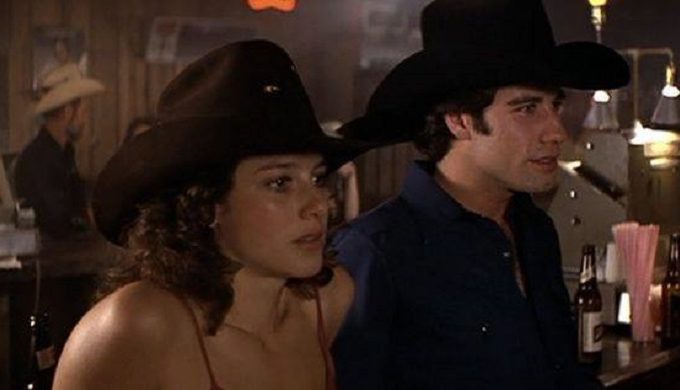38 years ago this June (the 5th, to be exact), the movie “Urban Cowboy” premiered in a Houston, Texas theater, featuring a post-showing charity gala which was packed to the cowboy-hat-brim with stars. The event was hosted by Lynn Wyatt, one of the city’s most prominent socialites. Party location: Gilley’s.
Billing itself as the largest honky-tonk in the world, this Pasadena nightclub was also the setting for the John Travolta and Debra Winger film which told the story of the romance between Bud and Sissy (their respective characters). “Gilleyrats,” or regulars of Gilley’s, they meet here, have their wedding reception here, and their marriage hits the skids here when Bud forbids Sissy to ride the mechanical bull.
Photo: Facebook/Reel Star Nostalgia
The movie was a hit, to say the least. Houstonians were in the spotlight, Texas made the silver screen once more, and the wardrobe of John Travolta, Debra Winger, et al., were thrust into the spotlight, spawning an “Urban Cowboy”-esque lifestyle that was actually livable. For years, movie-goers had made popular the films that they loved for characters and roles they wished they could be. Now, there was a movie they really could adopt as an experience – from the hat down to the boots, and all things in between.
Over the course of the next year, mechanical bulls became all the rage. Texas chic became the style, and western wear went into high gear. Still don’t believe the movie inspired a lifestyle? By 1981, as the movie’s soundtrack singles were released, reports indicated that approximately 300 radio stations across the U.S. switched their formatting to country music. Everyone had a love affair with Texas in general and Houston specifically, the same way fans fell for John Travolta. (It was reported that water from a pothole his character Bud had fallen into on set was being bottled and sold for $25 each!)
Photo: Facebook/Groovy History
The film’s popularity has since declined, and reference to its title (at least in Nashville) seems tantamount to something fake or diluted at best. However, it spawned a generation of those who wanted country-in-the-city: give me my urban job which I need to survive, but I want my country lifestyle in the hours past quitting time. Before the term “crossover hit” was even coined, “Urban Cowboy” was generating heat on the airwaves by big-selling artists jumping charts from rock to country appeal. It was also the first of its movie genre for that year, leading the way for others to be released such as “Honeysuckle Rose” (starring Willie Nelson) and “Coal Miner’s Daughter” (the life story of Loretta Lynn.)
Photo: Facebook/Sissy Davis-Urban Cowboy 1980
Despite the so-called fads that many will today say were generated from its release, “Urban Cowboy” did several things right. It released new life into the country and western atmosphere, it focused on Texas (who here would ever say that was a bad thing), and it portrayed the story of two real-life Texans. That’s right, the characters of Bud and Sissy in real life were Dew and Betty. They did, in fact, enjoy their weekends at Gilley’s amongst their local counterparts, and though their fate would ultimately be divorce, for a short time, they were what many young American couples aimed to look and act like. “Urban Cowboy” was the movie phenomenon that inspired a lifestyle. It was achievable, looked like a whole lot of fun, and to this day remnants can still be found in the uptick of western wear designs, boutiques, and high-end Texas fashion for men and women. Houston shone in the spotlight and Gilley’s simply set the perfect stage for that to happen.





